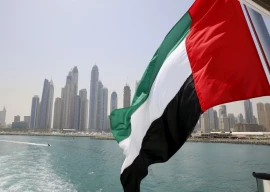
Sashaying down in six-inch heels and striking a pose at every stop and turn, all the while looking glamorous may be no easy feat, but the runway continues to be an important component of the local fashion industry.
In the wake of an increased number of fashion showcases, one stops to think how lucrative they’ve been for sales at a time when the digital age has risen to prominence. With Instagram, Facebook and Twitter having taken centre stage, fashion has become the talk of the digital town. It’s easy for any fashion enthusiast to write a blog and garner a massive following. The Express Tribune talks to industry pioneers and novices to explore the relevance of the catwalk in today’s social media-saturated world.

Ali Xeeshan is among the few designers who leave the ramp with a lasting impression. Known for his theatrics and creative ideas, he believes that fashion shows are the primary way of communicating a designer’s vision or brand. “Fashion shows systemise a designer’s production, where they know they have to create a collection every summer or winter and clients wait for them. They have a completely different impact than social media,” he holds.
Zara Shahjahan, who regularly showcases at fashion weeks, says these showcases aren’t about sales to the masses but a showcase of one’s talent. Shehla Chatoor also considers fashion shows to be a contributory factor to a brand’s overall standing. “Fashion weeks in Pakistan don’t attract a lot of buyers, so they don’t directly result in sales, but they increase brand awareness on social and print media,” she argues.
Mahgul Rashid of Mahgul feels social media is an important source of communicating the reinvention of a brand. “But we intend to take part in fashion weeks because they formalise things,” she adds. Umaima Mustafa, whose brand was introduced in Karachi some time back, hasn’t taken part in any major shows besides the TDAP fashion showcase 2013, but she feels that it’s the natural next step for any designer. “The runway isn’t just to build a brand’s identity but it also opens up dialogue and forces designers to be increasingly innovative and cutting edge,” she says. Daraz.pk, an online portal for fashion shopping, recently held its first online fashion show about which co-founder Farees Shah states, “Fashion shows are important to give larger audiences an idea of your product range.”

Contrarily, Farah Talib Aziz, a brand that has built a loyal clientele in Karachi but never showcased at any fashion week, believes that the runway kills the ‘exclusivity’ of a brand. Brand manager Maliha Aziz explains, “For us as a brand, it’s important to stay exclusive and the exclusivity of a collection dies when it’s exposed to the media on the runway in every angle. These days, it’s a pure rat race of who can copy first, so we pick and choose what clothes to put out on the social media.” She further says, “Fashion shows in the internet age are almost an invitation for copycatting.” There are also seasoned designers, such as Bunto Kazmi, who have established themselves without fashion shows or social media. When approached to share her opinion on the matter, Kazmi refused to comment.
One can’t, however, deny the boost these shows have given to the fashion industry. Four major fashion weeks take place in Pakistan every year and, while some designers suffer the monotony of showcasing back-to-back in different cities, others, such as Faraz Manan, opt for solo fashion shows. “The trend abroad is to have solo fashion show’s where one can be in control of all aspects of it and can control the guest list,” he states.
Social media has made fashion more democratic as designers can now receive instant feedback on their offerings. Shahjahan agreed, saying, “You get feedback from the real buyers rather than who’s sitting in the front row.” But this feedback needs to be monitored as you never know what your potential customer approves of and, at times, nasty comments become extensive.
Published in The Express Tribune, June 24th, 2015.
Like Life & Style on Facebook, follow @ETLifeandStyle on Twitter for the latest in fashion, gossip and entertainment.























COMMENTS
Comments are moderated and generally will be posted if they are on-topic and not abusive.
For more information, please see our Comments FAQ